iPhone 6S Review
iPhone 6S Review
Still good in many ways, but it’ll benefit a lot from iOS 12

Verdict
Pros
- Great look and feel
- 3D Touch adds interesting new dimension
- Subtle but useful camera improvements
- Clever front-facing camera flash
Cons
- Battery will deter power users
- No wireless charging
- Others charge faster
Key Specifications
- Review Price: £539.00
- 4.7-inch, 326ppi LCD
- 7.1mm thick
- 143g
- 1.8GHz Dual-Core
- 2GB RAM
- 16/64/128GB storage
- 12-megapixel iSight camera
- 5-megapixel Facetime HD camera
What is the iPhone 6S?
The iPhone 8 and iPhone X are here. But, the iPhone 6S is still available, with pricing starting at £449. For a phone that is about to celebrate its third birthday that’s a big price to pay.
For £50 more you can pick up the fantastic OnePlus 6 which has the iPhone 6S beat in every single category. There’s also the Honor 10 which is a similar price and again a much better buy.
Thankfully you can find the iPhone 6S for much less outside of the Apple Store. A refurbished 64GB unit from Amazon will cost about £250 – a much fairer price.
The big boost for the iPhone is also in the works. When it launches later in the year iOS 12 should seriously help performance on this device.
Apple is touting faster camera performance plus boosts to everyday tasks like opening apps and the keyboard. We’ll have a completely new review of the iPhone 6S when iOS 12 is available to the public
Related: Best iPhone Deals
iPhone 6S – Design
All ‘S’ phones look like their forebears and the iPhone 6S is no different. The fact that Apple still uses the basic iPhone 6S design for the iPhone 8 shows how much it believes in it.
The flat back, curved sides and large bezel around the display have become iconic traits that have stood the test of time. The phone’s design still measures up against more modern looking phones for the most part.
Not all is top-drawer though. The antenna bands that snake their way around back and sides are hideously ugly, breaking up the otherwise seamless look.
Related: iPhone 8
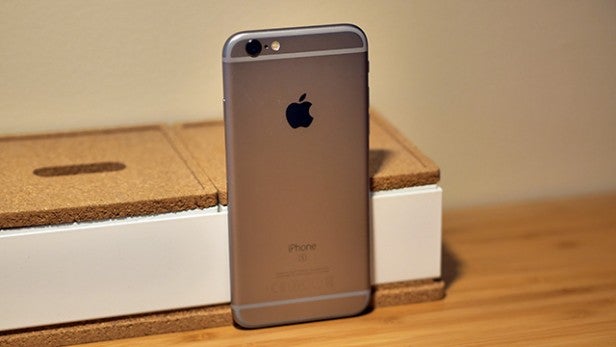
On the side you’ve got the power-button and volume keys, with the headphone jack and Lightning connector on the bottom. Below the display is the home-button with integrated Touch ID fingerprint sensor.
Unlike on the iPhone 7 and iPhone 8, the button here is a physical key that moves when you press it. Removing the mechanical button allowed the following iPhones to boast a water-resistance rating.
iPhone 6S – Screen
The screen is not the very best there is – Samsung’s OLEDs are in a different league – but it’s excellent for an LCD, even a few years on.
Contrast is great and colours are natural. Some might argue its 326 pixels per inch (ppi) isn’t sharp enough, but that argument doesn’t hold water with me. It’s plenty sharp enough.
3D Touch is, without question, the defining feature of the iPhone 6S’ screen. It lets the iPhone detect different levels of pressure and trigger new actions depending on how hard you press.
It’s the kind of feature that demands exploration and experimentation from users and developers alike. At first, you’ll explore the home screen – pressing harder on icons to see what happens. Sometimes it’s nothing, which is frustrating, but sometimes you’ll be
presented with shortcuts to specific actions.
For example, using “3D Touch” on the Camera app icon brings up shortcuts to take selfie or shoot a video. Try it on the Maps app and you can quickly share your location or get directions home. The Music app will launch the Beats1 radio station; the Calendar app will create a new event; the Wallet app will show you your last transaction. You get the idea.
All these little shortcuts are useful, but it’s inside apps where 3D Touch shows real dividends. My favourite feature is pressing down on the keyboard to drag the cursor around accurately. It’s a simple thing, but it makes correcting mistakes and basic editing simple and effortless.
Related: Best smartphones
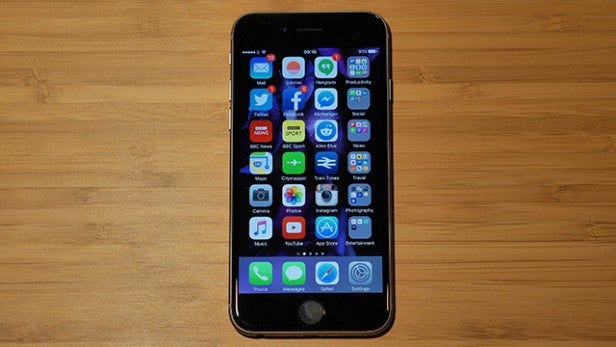
The other key strand of 3D Touch is what Apple calls ‘Peek’ and ‘Pop’. In short, press hard to ‘Peek’ at the contents of an item (e.g. an email, message or hyperlink) and press harder still to ‘Pop’ that into full screen. Relaxing the pressure, meanwhile, sends you back to where you came.
It that sounds naff and pointless to you, I assure you it isn’t. Mail and Messages are the best examples of how useful Peek and Pop is. Peeking into a message previews its contents without marking it as read, which shortens the irritating flow of checking a message, leaving it and then marking it as unread again to look at later.
Peeking and then sliding the window upwards reveals further actions, such as sending a standard reply or forwarding it to someone else. It’s great for checking a link to see if it’s genuinely useful, or you can slide it up and select ‘Open in new Tab’.
All of this is enhanced by the new Taptic Engine – a redesigned motor and software stack that delivers subtler, smarter taptic events.
I like it even more than 3D Touch itself. The way the Taptic Engine delivers short, precise and gentle ‘blips’ adds a new dimension to notifications. You’ll quickly learn the pattern and character of these vibrations, so you can instantly discern what kind of alert you’re getting without looking. You can customise them to an extent, too.
It’s a far cry from the iPhone 5 and 5S, which rumbled fiercely with all the subtlety of a small, yappy dog. Once you’ve used the iPhone 6S and experienced the difference, you’ll wonder how you ever put with that racket. It’s great.
The only downside is that, making room for the new Taptic Engine that helps power 3D Touch means a small, 5% reduction in battery capacity.
Related: iOS 12 features
iPhone 6S – Camera
On paper alone, there are legitimate reasons to be disappointed with the iPhone 6S’ camera. When it was first released the bump from 8-megapixels to 12-megapixels was very welcome. The fact Apple hadn’t upgraded the lens wasn’t. The iPhone 6S has an f/2.2 aperture lens, which is narrow by today’s standards.
This is important because a ‘wider’ aperture lets in more light onto the sensor. More light leads to better low light performance and superior ‘depth of field’ – where the background is blurred behind your subject.
The latter quality, often referred to as ‘bokeh’ – choose your own pronunciation of that one – is the desirable effect that gives photos that professional sheen.
It would be nicer still if the iPhone 6S had optical image stabilisation (OIS) as its ability to counter shaky hand motions would help low light performance even more, but that’s reserved for the larger iPhone 6S Plus for size reasons. This is arguably a greater loss than a faster lens, but you’ll only miss it when shooting in very low light, or for video.
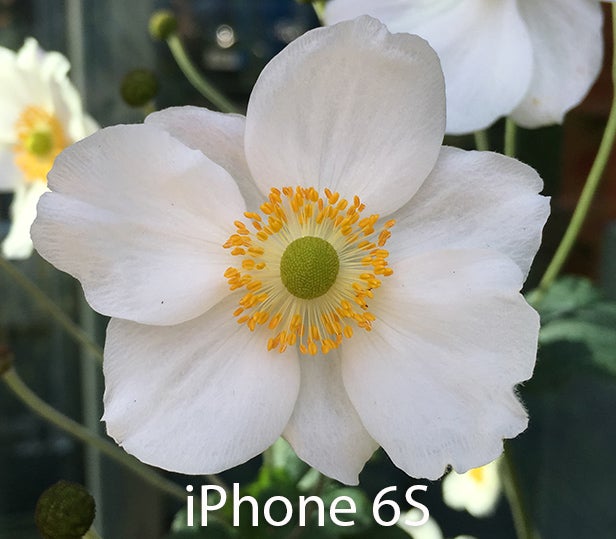
The iPhone 6S controls noise a little better and retains the contours of the petal as a result. It’s all fine margins, but it’s a good start.
HDR is an especially useful technique that combines different ‘exposures’ of the same shot. This helps resolve extremes of light and dark that a single shot can’t.
But it reinforces how the iPhone 6S remains an outstanding cameraphone. It renders colours faithfully with nice, smooth gradations that bring out the subtleties of shots, and it has excellent native dynamic range.
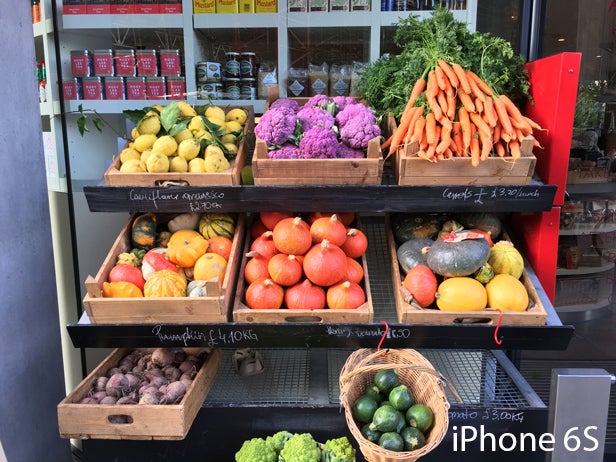
The vegetable stand above shows this nicely where the pumpkins (centre of shot) transition from red to orange.
The iPhone 6 produces a usable(ish) shot for social media, but it’s blotchy and struggles to control refractions from the bright lights.
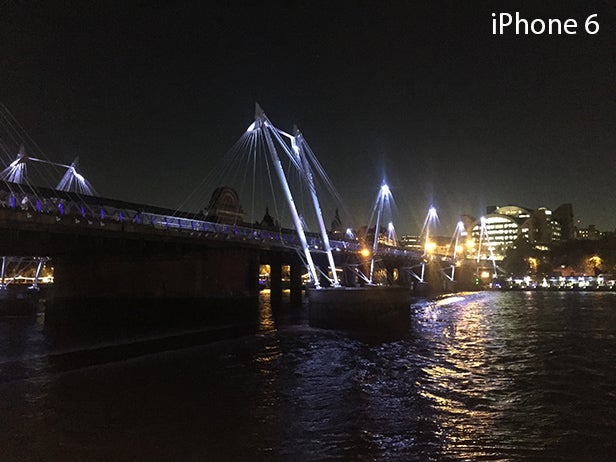
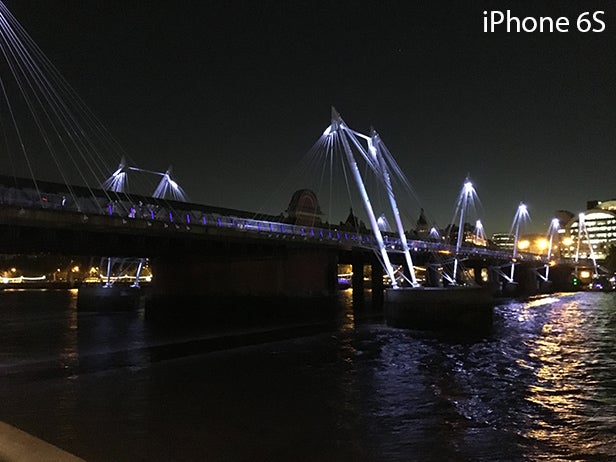
The noise in the dark sky of the 6S shot is much finer and controlled, and the lights don’t cause such serious problems. It’s a decent effort, but there are better.
Needless to say, the differences between the iPhone 6S and iPhone 5S are more extreme. We’ll explore this in a future update to our iPhone 6S vs iPhone 5S comparison, but the words “no contest” spring to mind.
Beyond pure image quality, there are noticeable improvements in performance, too. The iPhone 6S focusses faster than the iPhone 6 for one as it spends less time hunting back and forth.
Apple has lavished the iPhone 6S with a serious front camera upgrade this time around. It’s up from 1.2-megapixels to 5-megapixels, a pixel increase that has more in common with the inflation rate of your average banana republic.
The ‘screen flash’ is handy in dingy indoor lighting, the primary locale for the selfie. Like the dual-tone LED flash at the rear, the screen uses a flesh tone to avoid turning you too ghostly. It’s effective, too, aside from the odd white spot on my nose. Is “shiny nose” a thing?
Incidentally, Apple’s resisted the trend for strapping wide angle lenses on the front of phones. This makes it tricky to take ‘groufies’ without one of those stick-o-ma-bobs (umbrella’s, I think?), but affords just enough space to show how awesome your holiday destination is while you gurn furiously in the foreground.
The iPhone 6S’s video capabilities are good. It’s only held back, again, by the lack of optical image stabilisation, which is handy for suppressing shaky hands.
There are two video modes and six settings in total: 720p at 30fps, 1080p at 30fps, 1080p at 60fps, 4K at 30fps and the two slo-mo modes, 720p at 120fps and 240fps.
The 240fps mode introduced on the iPhone 6 is especially fun. The 60fps 1080p mode is interesting since it delivers smoother motion, though be warned it’s unusable in low light. As is 4K for that matter. The default mode is 1080p at 30fps, which is perfect for most conditions.
Moreover, while it’s easy to dismiss the addition of 4K as “pointless”, don’t be too hasty. For one, downscaling 4K footage to 1080p will result in sharper footing than native 1080p. The adventurous can even use 4K’s extra pixels to reframe and ‘zoom’ into their footage at 1080p without losing detail – 4K is effectively four times 1080p, after all.
Inexplicably, though, you can’t change the standard video and slo-mo options from within the Camera app. You have to delve into the Photos & Camera section of the Settings app to change the defaults every time, a decision so inexplicably stupid it defies belief.
It’s odd because the iPhone’s Camera app is impeccably designed otherwise.
iPhone 6S – Software
On release the iPhone ran iOS 9, buy one today though and you’ll be upgrading to iOS 11.
iOS 11 is arguably the biggest issue with the phone right now. It feels like an OS designed for Apple’s newer phones, rather than the older ones. Thankfully that should change when iOS 12 hits later in the year.
iOS 12 is an update less about bringing in new features (though, of course there are still a few) but fixing performance and stability on older phones. Apple says that everything from keyboard speed to camera performance should be improved and this could be a big boost for the iPhone 6S.Expect to see iOS 12 launch probably in September and we’ll fully re-review the iPhone 6S once it is out. There’s a public and dev preview available now, if you want to take it for a spin.
iOS 12 features that aren’t related to performance include a Screen Time feature for restricting and tracking time spent in certain apps, updated notifications and a few redesigned core apps like News and Books. All the of these features will also come to the iPhone 6S.
iPhone 6S – Performance
The iPhone 6S is hell-a-fast, which is apparently not as fast as “stupidfast” but is nonetheless pretty nippy.
Apple’s A9 SoC (System on a Chip) houses a shiny new PowerVR GPU and two CPU cores clocked at 1.8GHz each, up from 1.4GHz, and there’s 2GB of RAM.
Having two whole gigabytes of RAM isn’t a big deal these days, Android phones generally have at least 4-6GB. But the iPhone 6S runs fine with it.
With the iPhone 6S, I’ve managed to switch between as many as 10 tabs in Safari simultaneously loaded tabs without any reloads.
You could probably load a few more, but by that point I was satisfied. They’ll still reload if you leave the app and come back some time later, but in the time you’re active within Safari it handles the workload well.
Related: Best tablet 2018
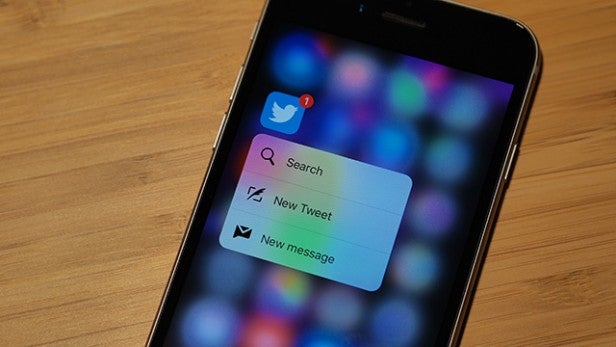
iPhone 5S and iPhone 6 owners will notice unlocking from Touch ID is faster, too, especially when the screen is already off. It’s only a small point, but each fraction makes the whole experience feel smoother and slicker.
There’s an enviable amount of graphics grunt on tap, too – not that any game I’ve found makes full use of it yet.
iPhone 6S – Battery Life
“Battery life could be a problem,” was my first thought when I started my iPhone 6S review, and with good reason. Wonderful though 3D Touch and the Taptic Engine are, Apple had to reduce the battery capacity from 1,810mAh to 1,715mAh to fit them in. It made the 6S slightly thicker and heavier, too, though not enough that anyone should care.
The iPhone 6 didn’t have a stellar reputation for battery life, and while some of those complaints are overblown, they’re not without foundation. Certainly, the ‘Plus’ variant is the phone to go for if you suffer range “range anxiety”.
For whatever reason, the Facebook app uses more background time than other app. Before the change Facebook was responsible for close to 25% of the phone’s battery drain, despite being on screen for just 20 minutes or so. iOS 9’s improved battery monitoring was a godsend here.
Navigation puts a big strain on the battery, though, particularly in built-up areas. One 15-minute walk with directions drained 7% from the battery. Streaming video over Wi-Fi burns through around 12% of battery per hour, depending on the quality and how bright your screen is.
The Low Power won’t extend your life indefinitely, but it’s useful and effective enough. iOS prompts you to turn it on when your battery hits 20% and it turns off all background activity, while also throttling down the CPU and GPU.
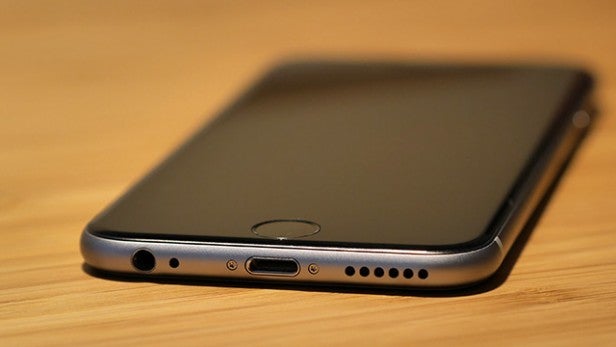
The iPhone is already frugal when idle, but Low Power extends that further still – I once got five hours of very light use after passing 20%, which is handy if you’re staying out late. And you can turn Low Power on earlier if you know you have a long day ahead – the iPhone 6S runs fine when it’s on.
Ultimately, while some management is needed from time to time, I never felt like I would run out before I got home, and it would only concern me if I was on a “night out” and got home late. In those cases, a few simple precautions will avert problems.
Power users who stream video all day, use navigation lots or play games often should look at the 6S Plus, but the 6S’s battery life is fine for the majority of people.
Why buy the iPhone 6S?
For the current RRP of £449, the iPhone 6S is far too expensive. There’s just too many better options out there for the same price. iOS 12 will likely make it a much better device, but that isn’t here yet and there are notable performance problems on older iPhones with iOS 11.
Related: How to download iOS 12
If you can pick the iPhone 6S up cheaper and you simply must have an iOS phone then you might even see benefits with installing the iOS 12 public beta.
Verdict
Still good in many ways, but it’ll benefit a lot from iOS 12.
How we test phones
We test every mobile phone we review thoroughly. We use industry standard tests to compare features properly and we use the phone as our main device over the review period. We’ll always tell you what we find and we never, ever, accept money to review a product.
Trusted Score
Score in detail
-
Performance 10
-
Camera 9
-
Design 9
-
Battery Life 7
-
Value 8
-
Software 9
-
Calls & Sound 8
-
Screen Quality 9


